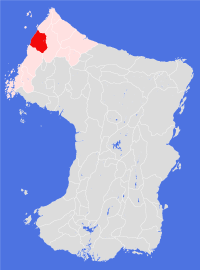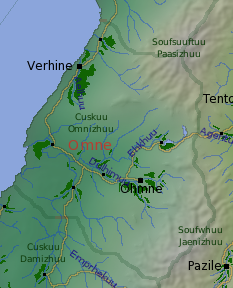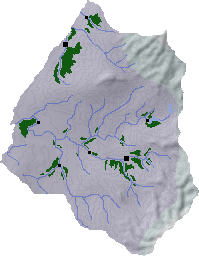Omne

Societal ties: Bartak
Current population: 1
Main language(s): Dam Bathtel
Area: 153,000km²
Natural and political borders
The Land of Omne stretches from the western coast (Smikuu Verhinen, Smikuu Tilhekrhistuun) east to the Soufsuuftuu Paasizhuu and Soufwhuu Jaenizhuu mountain chains.
As part of the New Agreement, the northern border with Lejune is set on the coastline at latitude 48.0°N. The border with Damose to the south is set on the river Tilhekrhistuu at latitude 40.5°N, agreed as part of the gt716 peace treaty following the war of gt712.
History
Verine Plantation was the third cultivation started by the Kaarname islanders, with help from Lejune settlers, to cope with the influx of refugees from the Tells region of Cheidrah. The first refugees arrived in gt523, and the Plantation quickly established itself as the destination of choice for emigrants.
Cultivation of the coastal reaches of the Tilhekrhistuu river began in the gt550s, and a new plantation was established along the Dulhimuu river in the gt560s by one of the greatest of the early soil brewers, Cazassa Ohmne - the plantation, and the city that grew in its midst, adopted his name following his death, as did the Land when that was first established.
In gt563 the first Telik ship arrived in Verhine - an exploratory expedition that had been blown off course by a major typhoon in the south. Trading between the Telik Lands on the south east coast of the continent soon started, and continue to this day. While goods were always welcome, the ideas and philosophies of the Telik traders were mostly ignored or ridiculed by Bartak Society. However, one idea - the concept of organising settlements into larger 'Lands' where the balance of power stayed at the local level - was embraced. Partly to enhance trade with the Telik, and partly to normalise political relationships between Verhine and Ohmne Plantations, the Land of Ohmne was created in gt593.
For the next century, the focus of Tells emigration turned south and east, leaving the new Land to stabilise and develop without having to deal with external pressures. Most growth took place in Ohmne Plantation, where the city developed a strong manufacturing base driven in part by advances in technology; Ohmne University opened in gt623.
A new settlement was developed on the Tilhekrhistuu river in the gt670s, principally to exploit the resources of the valley - an area that was also being explored and exploited by settlers from Damose. As competition for resources grew between the two groups, so did their bellicosity towards each other. By gt710 both sides had standing armies and a rapidly developing arms industry.
The inevitable came to pass in gt712 when armed conflict between the two sides escalated into war. The war was an intermittent affair, with no quarter given by either side. Battles were bloody and the numbers of dead and wounded quickly rose. The shock of war had a profound effect on both sides, and sanity finally prevailed just over an orbit later when both sides agreed to a cease-fire.
Negotiations for a more permanent peace took a further three orbits, though a renewal of hostilities was never a serious possibility. In gt716 the southern settlements constituted themselves as the Land of Damose, which immediately signed a peace and reconciliation treaty with the Land of Omne.
The repercussions of the war were far more widespread. All Bartak Society was shocked by the conflict. In gt720 the key Bartak Lands and settlements agreed to establish the Bartekol League, of which the Land of Omne was a founding member.
The war also had local repercussions. Much of the blame for promoting the conflict fell on the central authorities - power had been slowly seeping towards the centre since the Land was first established; the pro-nationalistic stance of the temples was also viewed as a contributing factor. Within ten orbits of the conflict's end, power had been removed from the centre back to the neighbourhoods, and the temples barred from formal politics. In place of the temples, neighbourhood committees were established and a separate judicial system inaugurated - a system which continues to this day.
Economically, Omne recovered quite quickly from the war, managing to convert arms manufacture to other purposes, while continuing to develop and refine the technological base of the economy.
The Land was a lead instigator in the reform of the Bartekol League in gt751, which again saw the seepage of power to a centralising authority halted. A century later, Omne led the campaign to build new trade routes through the mountains - in part to break the stranglehold that Koletane traders held on trade between the eastern and western parts of Bartak Society; the Ehkhuu-Agentuu trail linking Ohmne and Tentole (in Aelhpaase) opened in gt867. A new settlement on the trade route was established in gt890.

Politics and economy
Political power in the Land is highly decentralised to formal neighbourhoods (numbering between 60 and 70, depending on function and demographic changes), with the centre only allowed enough power to maintain a small standing army and navy, and to administer the University in Ohmne). The legal system is separated from the political system, and is again decentralised. Representatives to the central authority, which meets for 80 days every second orbit, are elected or appointed by these neighbourhoods - Omne is unique among Bartak Lands in that some neighbourhoods select their representatives using a lottery system.
The temples are barred by mandate from taking an active part in national or local politics - though this doesn't stop them from having an influence on the decision-making process. The Omne temples are fairly cohesive, with many temples belonging to the Goddess in Omne hierarchy. Temples continue to play a critical role in the education of all children between the ages of 5 and 10.
The national currency started as a system of vouchers between neighbourhoods, temples, business partnerships and the university in Ohmne for the provision of more advanced education and training. By the 850s, the voucher system was being used for most transactions within the Land, and was formalised as a national currency in gt887.
While agriculture underpins the economy, industrial and light manufacturing are also very important, as are personal and other services. With the recent development of information and communication technologies, mining for raw materials has also become more important - the first deep mine in the Land only opened in 1055.
Culture and other issues of interest
Omne society appears to emphasise the mother as the most important component of the family, followed by grandmothers and aunts, then fathers. This almost-worship of the mother role across all parts of the society has arguably had a detrimental effect on the role of women outside of the family - Omne folk (of both sexes) can be quite mysogenistic towards women in the workplace - and hostile towards women who choose not to have children. Ambitious women tend to emigrate as soon as they get the chance.
Omne folk also appear to be more respectful and deferential towards rich people - especially those that inherit money for some reason. Personal effects are generally willed to the oldest child; where the oldest child is female, they will often face family pressure to give a large part of that inheritance to their younger brothers.
More than in other Bartak Lands, families (especially the mother) will play a role in arranging partnerships between young people - more than 60 per cent of young people have their first partnership arranged by the family, and the partnership is expected to endure for around 10 orbits as a minimum; there is a social stigma attached to those who split before this time.
Music is the national passion: everybody can play at least one instrument; and competitive musical events are common.
Key natural features
Omne consists of a series of broad, shallow river valleys which are collectively known as Cuskuu Omnizhuu. The northern valleys drain directly to the sea, while the southern valleys - including the Ehkhuu and Dulhimuu river valleys - join the Tilhekrhistuu river which reaches the sea around 90km north of the southern border.

Habitats
Over 90 per cent of the Land's territory is western coastal habitat.
Plantations and settlements
The oldest plantation in the Land - Verhine - stretches some 90km along the lower reaches of the Aelhuu river, and has expanded to include much of the land between the river and the coast. The Ohmne Plantation along the river Dulhimuu and its tributaries is more substantial, roughly 80km square (of which about 50 per cent of the land is cultivated).
Five other settlements continue to prosper, one on the coast north of Verhine, one downriver from Ohmne, two on the Tilhekrhistuu river and a more recent settlement around the high lakes of the Ehkhuu valley.
Key towns and cities
Rural population: 0 (0.0% of total)